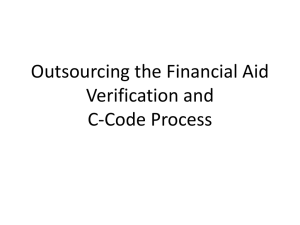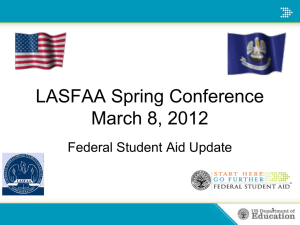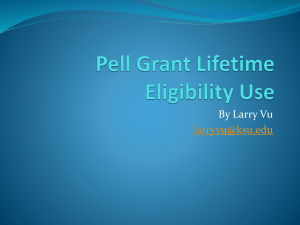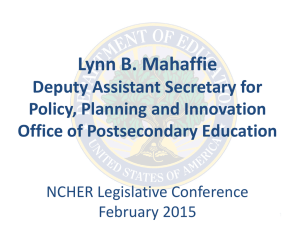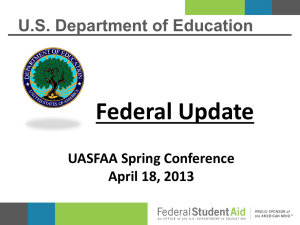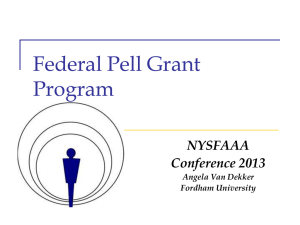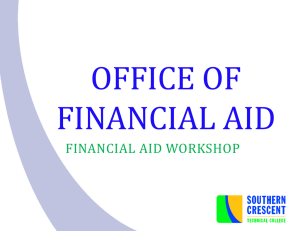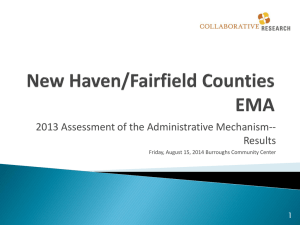U.S. Department Of Education
advertisement
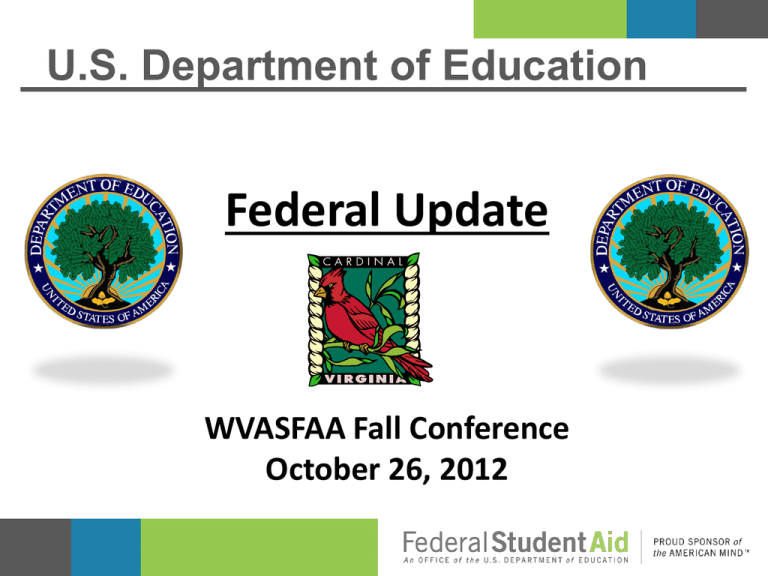
U.S. Department of Education Federal Update WVASFAA Fall Conference October 26, 2012 2 Pell - LEU LEU – Lifetime Eligibility Used Reduces the duration of a student’s eligibility to receive Pell Grant to 12 semesters (600% - 6 full Scheduled Awards) Applies to all students effective with the 2012-13 award year. Calculation includes all earlier years of the student’s receipt of Pell NO “grandfather” clause 3 Pell - LEU Calculate the equivalency by adding together each of the annual percentages of a student’s scheduled award that was actually disbursed to the student. Once LEU reaches 600%, student no longer eligible for Pell May impact FSEOG eligibility If LEU more than 500% but less than 600%, partial eligibility for next award year 4 Pell - LEU EA posted on February 17, April 6, June 29 Beginning in July 2012 – NSLDS will display student’s LEU CPS will use comment codes on ISIRs/SARs to flag students LEU is almost/exceeds 600%. New COD Pell LEU History page COD is the system of record for LEUs If report a disbursement but don’t disburse or don’t disburse in full, MUST adjust (more important now than ever due to the 600% limit) Report adjustments within 30 days (8/13/12 EA) 5 Pell - LEU • If less than 100% eligibility remaining, handle award like a transfer student • Pay up to full amount allowed in first payment period/term • Pay remaining balance in subsequent payment periods • Do NOT spread out percentage evenly over remaining periods • May round cents but cannot exceed 600% 6 Pell – LEU (Example) Student’s annual Pell award is $4800 (100%) Student’s current LEU is 523.867% of 600% • Student has 76.133% LEU remaining • Do not round percentages • 76.133% of the student’s annual award is $3654.384 • Disburse 50% of annual award ($4800) 1st term = $2400 (assuming full-time student) Disburse remainder of annual award in second term, up to the remainder of their LEU = $1254.384 (26.133%) • May round the dollar amount down to $1254 (26.125%), or award the cents $1254.38 (26.133%) 7 Declining Pell - GEN-12-18 • Students can decline all or part of their Pell Grant awards or return some previously received Pell Grant funds to preserve future Pell Grant eligibility Student may not return any Pell Grant funds from a prior award year (must take place in same award year) • Student must provide a signed, written statement clearly indicating that they are declining/returning Pell funds for which they are otherwise eligible and that those funds may not be available once the award year is over • School must submit any required adjustment records for the student to the COD System • 8 Federal Register – May 2, 2012 Removed regulations pertaining to a 2nd scheduled Pell Grant (2 Pells in one award year) Crossover Payment Period (period in 2 award years) Removed requirement to compare ISIRs from both award years and pay from the year with the higher payment The school will determine which award year the payment period will be placed (34 CFR 690.64) Ability to meet need’s of the student and maximize eligibility The entire payment period must be considered in ONE award year and the entire disbursement must be paid out of the award year in which it was placed 9 Effective May 2, 2012 GEN-11-16 10 Graduate Students Subsidized Loans eliminated for Graduate Students Effective for loans made for loan periods beginning on or after July 1, 2012. Subsidized Loans for loan periods beginning before July 1, 2012 remain unchanged COD will edit for changes. Annual limits unchanged, all unsubsidized ($20,500) Students still eligible for subsidized loans for preparatory coursework and teacher certification programs 11 Upfront Rebates Elimination of Direct Loan Incentives Terminates repayment incentives (“upfront rebate”) to encourage on-time repayment of loans Effective for loans first disbursed on or after July 1, 2012 COD will edit for compliance An actual disbursement takes precedence over an anticipated disbursement Still allows interest rate reduction to borrowers who repay electronically 12 Grace Period Interest Subsidy Temporarily eliminates the interest subsidy on Direct Subsidized Loans during the six month grace period Applies to new Direct Stafford Loans for which the first disbursement is made on or after July 1, 2012, and before July 1, 2014 13 Interest Rates and Sub Eligibility 3.4% interest rates for subsidized loans disbursed on or after 7/1/12 & before 7/1/13 New Subsidized limits: New borrowers on or after July 1, 2013 will be eligible for Subsidized Loans up to 150% of published program length Once 150% limit reached, ineligible for interest subsidy benefits on all subsidized loans first disbursed on or after July 1, 2013 More guidance coming! 14 EA dated 7/10/12 Aggregate Loan Limits If a dependent student’s parent is denied a PLUS, the dependent student can borrow up to the annual independent student loan levels. • Amounts able to borrow because considered an independent student does not count against dependent aggregate loan limits • Amounts able to borrow as dependent student (i.e. 1st year dependent student can borrow $3500 – base sub/unsub and $2000 additional unsub) would still count against dependent aggregate loan limits. • Undergrads can never exceed overall total aggregate of $57,500 15 16 Awarding FSEOG • Pell Grant recipients with lowest EFCs • • • Not receiving Pell Grant with lowest EFCs • • 17 Known as FSEOG first selection group Not necessary to receive a Pell Grant in the same payment period as FSEOG • Must be received in same award year • Example: student only receives Pell Grant in Fall due to reaching Pell LEU Known as FSEOG second selection group May be selected after all Pell recipients have been awarded • Includes students who exceed Pell LEU for entire award year Perkins: Liquidation and Assignment • Updated procedures in August 5, 2011 EA Contains details on liquidation & assignment procedures • Updated procedures coming soon! • • Liquidation of portfolio required when: School voluntarily withdraws from program • School no longer advancing loans to students • School participation is terminated by ED • perkinsliquid@ed.gov 18 Disbursing FWS Wages • Crossover Payment Periods • • Compensation earned through June 30 is paid with funds allocated for first award year Compensation earned starting July 1 is paid with funds allocated for the following year • FWS students may be paid overtime in accordance w/applicable labor rules • Students may earn academic credit and FWS compensation but may not be: • • • 19 Paid less than if no credit were given Paid for time receiving instruction Paid unless employer often pays nonFWS person for same job CB Use of Funds - Tips • Are we avoiding penalty for underuse of funds? Do not request more funding than can be used • Transfer funds to FSEOG/FWS • Carry-forward; carry-back • Taking Campus-Based ACA as appropriate • Up to 10% or $75,000 of FWS allocation may be used for job location and development under the JLD program • 20 Common FISAP Errors • Failure to make required revisions Impacts tentative and final awards • Annual funding may be reduced in G5 by ED • No reinstatement of funds for reporting errors • December 15 deadline date to make revisions • After December 15, revisions must be requested through CB program staff • School does not coordinate with other offices on campus in collecting/reconciling info. • 21 G5 Issues • CB funds transferred from one program to another must be entered in G5 as an expenditure against the program from which they were transferred. • FWS or FSEOG funds carried forward or back must be entered in G5 as an expenditure against the authorization for the award year from which they were taken • Do not attempt to transfer CB funds in G5 • 22 A June 28, 2012 Electronic Announcement explains that schools are no longer able to systematically transfer funds between programs, schools or award years. 23 Ability-to-Benefit (ATB) Eliminates Title IV eligibility for students without a high school diploma (or equivalent) Recognized equivalent of a HSD includes: GED State certificate passing State authorized exam State considers same as HSD Academic transcript of successful completion of at least a 2year program acceptable for full credit toward a Bachelor’s degree Excelled academically in high school and meets admission policy into at least an AA degree Home schooled students 24 Ability-to-Benefit: Exception Students who attended a Title IV eligible program of study prior to July 1, 2012 OR officially registered for a TIV eligible program prior to July 1, 2012 AND later attended that program may continue to qualify under one of the ATB alternatives – Passing an independently administered, approved ATB test Successfully completing at least six credit hours or 225 clock hours 25 Ability-to-Benefit: Exception Students do not have to have received Title IV aid prior to July 1, 2012 to qualify for the ATB exceptions School must document student qualifies for use of ATB alternative NSLDS, transcripts, other documentation from previous school indicating enrollment in eligible program GEN-12-09 - provides a “grandfather” test and various scenarios to assist determine if a student qualifies for the ATB alternative 26 27 Graduate Programs At this time graduate schools may continue to follow our written guidance on the program integrity website which states that the repeat coursework regulations only apply to undergraduates Repeat coursework and graduate programs is currently under review Stay tuned to IFAP 28 29 SAP – Clock Hours • Evaluation “at end of payment period” • Schools have 3 options 1) At the point when the student’s scheduled clock hours for the payment period have elapsed, regardless of whether the student attended them; or 2) At the point when the student has attended the scheduled clock hours; or 3) At the point when the student successfully completes the scheduled clock hours for that payment period 30 School must establish one review option for a program; cannot start with one option and then after the first review, switch to a different option for that cohort of students. SAP – Pace Calculation Example Background • • • • • • 1200 clock hour program, 40 weeks Payment periods – 450 hrs/15wks; 450/15; 300/10 Student scheduled 30 hours per week Max timeframe is 150% of 40 weeks = 60 weeks 67% completion rate to measure pace Evaluate SAP each payment period Program Integrity Q & A website – SAP Question R-Q9 http://www2.ed.gov/policy/highered/reg/hearulemaking/2009/integ rity-qa.html 31 SAP – Pace Calculation Example Option #1 – Scheduled hours • At 450 scheduled hours, completed 300 hours • 300/450 = 67% or, as expressed in calendar time, 10 weeks/15 weeks = 67%. • Both items checked according to max timeframe • Standard rounding is allowed Student is making SAP but not eligible for 2nd disbursement until successfully completes 450 hours and 15 weeks of instructional time. • Next SAP review is at 900 scheduled hours • 32 SAP – Pace Calculation Example Option #2 – Attended hours • At 450 attended hours, 600 scheduled hours elapsed • 450/600 = 75% or, as expressed in calendar time, 15 weeks/20 weeks = 75%. • Both items checked according to max timeframe • Standard rounding is allowed Student is making SAP but not eligible for 2nd disbursement until successfully completes 450 hours and 15 weeks of instructional time. • Next SAP review is at 900 attended hours • 33 SAP – Pace Calculation Example Option #3 – Successfully completed hours • • At 450 successfully completed hours, 600 scheduled hours elapsed 450/600 = 75% or, as expressed in calendar time, 15 weeks/20 weeks = 75%. • • • 34 Both items checked according to max timeframe • Standard rounding is allowed Because student has successfully completed both the hours and the weeks in the payment period, the second disbursement could be made at this time Next review is at 900 successfully completed hours GEN-12-10 EA – 6/29/12 35 E.O. 13607 Signed April 27, 2012 • Designed to ensure information, support and protections put in place for those students enrolled in post-secondary programs receiving federal military educational benefits • Schools participating in certain federal military education benefits enter into an agreement/understanding with DOD and VA • 6/29/12 EA provides a link to recorded webinar and the executive order • 36 E.O. 13607 • GEN-12-10 provides a series of Q & As to address how TIV schools can comply with EO 13607 cost form – ED’s “Shopping Sheet” • Aid Information – provides sample language • State Authorization and recruitment – follow existing ED regulations around state authorization, misrepresentation, recruitment and incentive compensation • Accreditation – follow accreditation requirements • Readmission – follow ED’s guidelines for returning service members • Standardized 37 E.O. 13607 • GEN-12-10 provides a series of Q & As to address how TIV schools can comply with EO 13607 – treat VA and DOD funds similar to R2T4 and nonTIV schools develop refund policy similar to R2T4 • Individual education plans – definitions/terms, degree requirements and transfer hour procedures • Advising points of contact – basic understanding of benefits and services for military/service and family members and contact information for additional help • Withdrawals 38 GEN-12-12 GEN-12-17 EA – 9/11/12 39 Shopping Sheet – 2013-2014 ED developed model format to deliver financial aid information to students - section 484 of HEOA • Encouraged to be used by schools starting in 13/14 • • If will use sheet, send email to ShoppingSheet@ed.gov with institutional name and institution’s OPE ID number • Required to be used by schools that agree to comply with Executive Order 13607 (principles of excellence) • 40 Provide prospective veteran/service member students with personalized form that contains standardized information describing program costs and costs that may be covered by available Federal educational benefits and financial aid Shopping Sheet – 2013-2014 • An annotated shopping sheet, along with background information about the sheet, can be found at – • • The sheet is for undergraduate and graduate students but can be modified as necessary • • ED will post comprehensive file on Department's Web site from which either an institution may pull its data or software providers may pull data on institution's behalf Shopping Sheet is currently in PDF format • 41 http://www2.ed.gov/policy/highered/guid/aid-offer/index.html Developing specifications for an HTML format available for institutions and software providers in Fall 2012 42 Gainful Employment Information Gainful Employment Page on IFAP at: http://ifap.ed.gov/GainfulEmploymentInfo/ or from IFAP Homepage (right-hand side) Regulations and Federal Register Notices Dear Colleague Letters and Electronic Announcements Frequently Asked Questions Training, including webinars Resources 43 Gainful Employment We are currently reviewing the recent legal decision about the Gainful Employment regulations. We are unable to respond to any questions related to Gainful Employment at this time, but will provide additional guidance in the near future Electronic Announcement dated July 6, 2012 (GE EA #39) • Provides background on decision • Current school requirements • Do not have to report annual data for 11/12 • Additional GE data not required to included for adding new GE programs • Disclosure requirements still in affect 44 Stay tuned to IFAP for Updates!!!! 45 Verification Documentation • Electronic Announcement – 7/20/12 Paper Tax Return “temporary” exception (GEN-12-07) • Beginning July 16, 2012, unless person meets exception listed in 8/21/12 EA, tax information must be verified by either using the IRS Data Retrieval Tool or by submitting IRS Tax Return Transcript • Note that the July 15, 2012 exception deadline for paper returns applies to receipt of the copy of the tax return and NOT to when verification must be completed. • 46 Verification Documentation • Tax Return Transcript Based on initial tax filing • Obtained in most situations where IRS Data Retrieval process cannot be used (or don’t use) • Exceptions – amended returns, identity theft, foreign countries, certain island nations and US commonwealths • Electronic Announcement dated 8/21/12 • – Updated with program integrity Q & A (DOC-Q2) 47 Verification Documentation • Amended Tax Returns 1) a signed copy of an original tax return; OR a Tax return transcript; AND 2) a signed copy of IRS form 1040X • Identity Theft 1) a signed copy of the paper IRS income tax return; AND 2) a signed copy of IRS Form 14039 “Identity Theft Affidavit” OR a signed statement, or police report if applicable 48 Tax Filers - Extensions • Person is required to file, but obtained extension, must submit: – IRS form 4868 or IRS approval to extend beyond October 15, 2012 – W-2 for each source of employment income – Signed statement by a self-employed individual certifying amount of AGI & US income tax paid for 2011 – When above documentation received, verification is considered complete (disbursements are valid) • School may request transcript/IRS DRT when taxes are filed 49 2013-14 Verification • Continuing to take small steps towards customized verification • Items to be verified will be grouped • Individual student’s ISIR record will indicate which group of items the student must verify • IRS Data Retrieval Tool will be available the first Sunday each February (2/3/13) 50 2013-14 Verification Verification items— • Retained all items subject to verification in 2012-13 • Added two new items High school completion status • Identity/Statement of Educational Purpose • Federal Register – July 12, 2012 DCL GEN-12-11 51 2013-14 Verification • Documentation of high school completion status: High school diploma; or • Final high school transcript that shows the date of graduation • Note: If a copy of an applicant’s high school diploma or final high school transcript is unavailable, the institution may accept alternative documentation 52 2013-14 Verification • Documentation of high school completion status: Recognized equivalent of a high school diploma • • • 53 General Educational Development (GED) Certificate; State certificate received by a student after the student has passed a State-authorized examination that the State recognizes as the equivalent of a high school diploma; Academic transcript of a student who has successfully completed at least a two-year program that is acceptable for full credit toward a bachelor's degree; or 2013-14 Verification • Documentation of high school completion status: recognized equivalent of a high school diploma • 54 For a person who is seeking enrollment in an educational program that leads to at least an associate degree or its equivalent and has not completed high school but has excelled academically in high school, documentation from the high school that the student excelled academically in high school and documentation from the postsecondary institution that the student has met the formalized, written policies of the postsecondary institution for admitting such students 2013-14 Verification • Documentation of high school completion status: Homeschooled • • 55 Transcript, or the equivalent, signed by the parent or guardian, that lists the secondary school courses completed by the applicant and documents the successful completion of a secondary school education; OR A secondary school completion credential for home school (other than a high school diploma or its recognized equivalent) provided for under State law 2013-14 Verification • Documentation of identity/statement of educational purpose • Appear in person and present to an institutionally authorized individual • A valid government-issued photo identification; and • A signed statement of educational purpose • Maintain, an annotated copy of the identification: • The date documentation was received; and • The name of the institutionally-authorized individual that obtained the documentation 56 2013-14 Verification • Documentation of identity/statement of educational purpose (cont.) • If unable to appear in person, must provide the institution— • A copy of a valid government-issued photo identification AND • An original, notarized statement of educational purpose signed by the applicant 57 Verification Tracking Groups • Verification flags • Verification tracking flags • Verification tracking groups • Items to verify based on group 58 V1– Standard –Tax Filers 59 ‒ Adjusted Gross Income ‒ U.S. Income Tax Paid ‒ Untaxed Portions of IRA Distributions ‒ Untaxed Portions of Pensions ‒ IRA Deductions and Payments ‒ Tax Exempt Interest Income ‒ Education Credits ‒ Number of Household Members ‒ Number in College ‒ Supplemental Nutrition Assistance Program (SNAP-Food Stamps) – if listed on FAFSA ‒ Child Support Paid - if listed on FAFSA V1—Standard (cont.) • Non-Tax Filers Income Earned from Work • Number of Household Members • Number in College • Supplemental Nutrition Assistance Program (SNAP-Food Stamps) – if listed on FAFSA • Child Support Paid - if listed on FAFSA • 60 V2—SNAP Supplemental Nutrition Assistance Program (SNAP-Food Stamps) (1) A statement signed by the applicant/parent affirming that SNAP–Food Stamps benefits were received by someone in the household during the 2011 and/or 2012 calendar years. (2) If school has concerns with accuracy of information, the institution must obtain documentation from the agency that issued the SNAP-Food Stamps benefits 61 V3—Child Support Paid Child Support Paid by the student (or spouse), the student’s parent or both (1) Statement signed by the applicant/parent certifying— (a) The amount of child support paid; (b) The name of the person who paid the child support; (c) The name of the person to whom child support was paid; and (d) The names of the children for whom child support was paid (2) If the institution has reason to believe that the information provided in the signed statement is inaccurate, the applicant must provide the institution with supporting documentation, such as— divorce decrees, checks, signed statements, etc. 62 V4—Custom • High School Completion Status • Identity/Statement of Educational Purpose • Supplemental Nutrition Assistance Program (SNAPFood Stamps) • Child Support Paid 63 V5—Aggregate • High School Completion Status • Identity/Statement of Educational Purpose AND • All items indicated-Tax Filer (V1) • All items indicated-Non-Tax Filer (V1) 64 65 HEOA Changes Increased CDR monitoring period from two to three years Beginning with the 2009 cohort, the calculation will be: Borrowers who default in that federal fiscal year or by the end of the next two federal fiscal years. Establishes a three-year transition period for sanctions On 9/17/12 - released the FY 2010 2-Year Cohort Default Rates to schools On 9/24/12 - released the FY 2009 3-Year Cohort Default Rates to schools 66 2-Year Versus 3-Year Calculation The Numerator is the number of borrowers from the denominator who default within a cohort period FY-09 FY-10 125 230 355 5000 7.1% 5,000 FY-09 125 5,000 67 FY-10 230 The Denominator is the number of borrowers who enter repayment within a cohort period .071 or FY-11 250 605 5000 .121 or 12.1% Transition Period 68 Default Sanctions* Default Prevention Plans 1st year CDR is equal to or greater than 30%: Establish a default prevention task force; and Develop and submit a default prevention plan to ED 2 consecutive CDRs equal to or greater than 30%: Revise and submit default prevention plan ED may require specific adjustments/actions 3 consecutive CDRs equal to or greater than 30%: Lose Direct Loan AND Pell Grant eligibility 1 CDR above 40% lose Direct Loan eligibility 69 *ability to appeal/ challenge rates Default Prevention ED’s Default Prevention Resource Center http://ifap.ed.gov/DefaultPreventionResourceInfo/index.html defaultpreventionassistance@ed.gov. Right-hand side of IFAP home page Webinar Recordings –Default Prevention Conference Several different presentations ANN-12-18 (http://ifap.ed.gov/dpcletters/ANN1218.html) ED Cohort Default Rate contacts (202) 70 377-4259;fsa.schools.default.management@ed.gov 71 NPRM – July 17, 2012 Create new Income Contingent Repayment (ICR) plan based on future changes to IBR ICR-A (new plan); ICR-B (current plan) ICR-A – maximum annual payment capped at 10% of discretionary income; qualify for loan forgiveness after 20 years of qualifying payments; borrower needs partial financial hardship; adjustments for married borrowers depending on filing status PROPOSED 72 NPRM – July 17, 2012 • Modify IBR plan to incorporate SAFRA Act Changes Becomes effective July 1, 2014 Redefine new borrower and partial financial hardship Maximum monthly payment limited to 10% of discretionary income Loan forgiveness after 20 years of qualifying payments Improve notification requirements Revised repayment requirements for borrowers who leave IBR PROPOSED 73 NPRM – July 17, 2012 • Total and Permanent Disability Discharge Perkins, FFEL and Direct Loans Borrowers representative can be involved in entire process Borrowers apply for discharge directly to ED who will notify all lenders ED to create an OMB form for reporting earnings Ensure application process for veterans with VA documentation similar to non-veteran process Revise provisions to require payments by borrowers after a discharge is granted be returned to the borrower 74 Federal Register – 9/27/2012 • Updated Waivers to HEROES Act – Assist military service members called to active duty or qualifying National Guard duty – Assist those residing or working in a declared disaster area tied to a national emergency, war or military operations – Waivers and Modifications include: - No grant overpayments owed under R2T4 - Signed statements of tax extensions - LOA requests to not have to be in writing - Credit balance timeframe met if contact attempted - Can hold balance up to 45 days 75 Federal Register – 9/27/2012 • Updated Waivers to HEROES Act –Waivers and Modifications include: - 60 day loan cancellation period - verbal authorizations allowed - various loan statuses and payment requirements - parental verification & FAFSA signature requirements - Effective 9/27/12 through 9/30/17 76 Future Federal Registers Teacher Preparation and TEACH Grants Institutional reporting & State accountability – quality of teacher preparation programs “High Quality” Program and Services Definitions associated with school eligibility to participate in TEACH Grant Service and Repayment obligations for TEACH 77 Future Federal Registers Other Student Loan Issues “Naturally readable” Direct Loan regulations Various aspects of defaulted borrower process Loan Rehabilitations Perkins loan issues – deferments, enrollment reporting, loan assignments… Fall 2012 Negotiated Rule-Making May 1, 2012 Federal Register Notice • Topics – preventing fraud; use of debit cards and other banking mechanisms for disbursing TIV; improve and streamline campus-based programs • 78 79 Dear Colleague Letters • GEN-12-13 – Program Integrity and State Authorization • • • • GEN-12-08 – Disbursing Title IV aid through Contractors GEN-12-03 – Students without a valid HS Diploma • • Series of Q & As including discussion around E-App, student complaints, additional locations and legal issues with distance ed Specifically mentions that schools still responsible for complying with all State laws as they pertain to distance education If institution identifies a student who did not possess a valid high school diploma when receiving Title IV aid for an award year prior to 2011-12, contact its School Participation Team GEN-11-17 – Fraud in Distance Education Programs 80 Electronic Announcements • • 9/26/12 – Electronic IBR application (studentloans.gov) 9/24/12 & 8/16/12 – NSLDS – “My Student Data Download” Button (Sept. 2012) • • • • Students can get loan, grant, enrollment, and overpayment information in plain text file vs. PDF format or Web page 7/3 & 7/20/12 – one website for students/families – StudentAid.gov 6/29/12 – Pell LEU System Enhancements 3/22/12 – new G-845 form to use for secondary paper confirmation 81 82 Training • FSA Conference • • • FSA Fall Webinar Series – October 2012 • • • R2T4 Modules, R2T4 Clock Hours, Clock Hour Issues, Campus-Based Programs, future Q & A session ANN-12-21 (recordings will be posted to IFAP) Fundamentals of Federal Student Aid Administration • • 83 Orlando, FL – November 27-30, 2012 fsaconferences.ed.gov ANN-12-22 New requirements – CEO/owner must attend entire training; to register participants must complete online training 83 Resources • IFAP.ed.gov website • • “My IFAP” – left-hand side Program Integrity Q & A website http://www2.ed.gov/policy/highered/reg/hearulemaking/2009/inte grity-qa.html (right-hand side on IFAP) • Campus-Based Call Center • • FERPA Office • 202-260-3887; ferpa@ed.gov Federal Loan School Support Team 84 877-801-7168; cbfob@ed.gov All DL schools have a POC - dlops@ed.gov 84 Contacts • Philadelphia School Participation Team • Main Number: 215-656-6442 • Joe Kern (IIS) – 215-656-8566 • Philadelphia Training Officers • Annmarie Weisman – 215-656-6456 • Craig Rorie – 215-656-5916 • Gregory Martin – 215-656-6452 • Email – firstname.lastname@ed.gov 85 Feedback on Training Jo Ann Borel Supervisor of Training Officers 281-758-8122; JoAnn.borel@ed.gov 86
